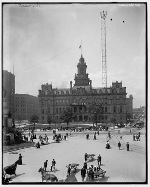On a hot summer day in 1882, Detroit’s residents gathered around city hall to witness drama, excitement, and most importantly—The Future. Unfortunately, LED lighting wouldn’t be invented for another century, but they had something equally as innovative and thrilling (for the time) to gawk at: moon lights.
I, Dr. Bulb, was not around to witness the age of moon lights. And I’m not sure if I’d want to! In Detroit, the moon lights were five-hundred pounds of lights anchored atop a 150-foot-tall pole meant to simulate moonlight, according to The Atlantic. The actual purpose of the lights was overshadowed by the possibility of danger. Often the poor manufacturing of the support poles would cause the moonlights to come crashing down to earth.
But it’s 2013 and I only see one moon in the sky. What happened to “The Future”?
In The Age of Edison: Electric Light and the Invention of Modern America, Ernest Freeberg describes the age of moon lights. While an eventual failure, the moon lights represent the early days of electricity and lighting ingenuity. Americans wanted to illuminate their cities—but they weren’t sure how. Street lights would be far too complicated and expensive, so they looked to the sky and tried to recreate the moon. Charles Francis Brush, an inventor and entrepreneur, was contacted by the town of Aurora, Illinois to install six iron towers with arc lamps above the city. With Thomas Edison as one of his major competitors, Brush was determined to illuminate the country with moon lights.
Sadly for Brush, many residents—and animals—were not happy with the new lighting systems. Light was everywhere at all times, killing exhausted animals who were unaccustomed to extended daytime. The moon lights could easily be blocked by trees or buildings, creating disorienting shadows. And imagine walking from day to night in just a few steps! Eventually they installed more towers to combat the issues, which defeated the entire purpose.
Street lights are looking like a great idea at this point. If only they had invented LED lighting!
The moon lights made it to Detroit in a business deal. Detroit wanted to be the “best lighted in the world” and Brush wanted publicity. Although many residents found the lights to be brilliant, others were not happy with the flawed method. The disadvantages soon overpowered the benefits and moon lights were replaced.
Interested in seeing a moon light in person? In 1894, Austin, Texas purchased 31 of Detroit’s towers and 17 survive today.
Now, we have more safer and more efficient mean of lighting such as LED wallpacks and LED bollards, the history of lighting has come a long way! Don’t forget to follow me on Twitter @doctorbulb and subscribe to my blog.



